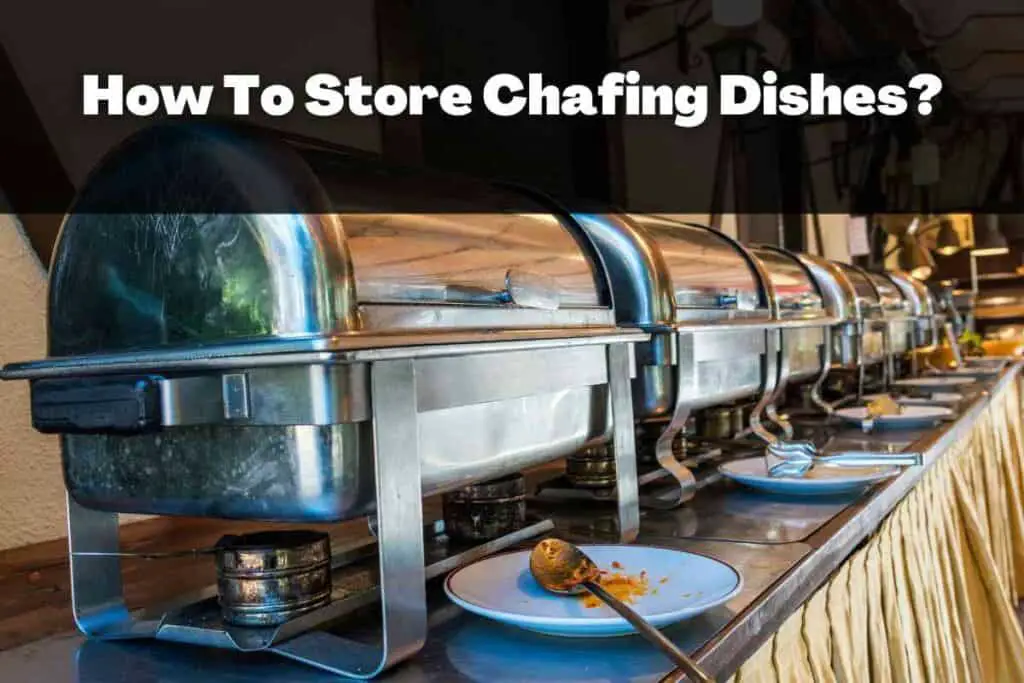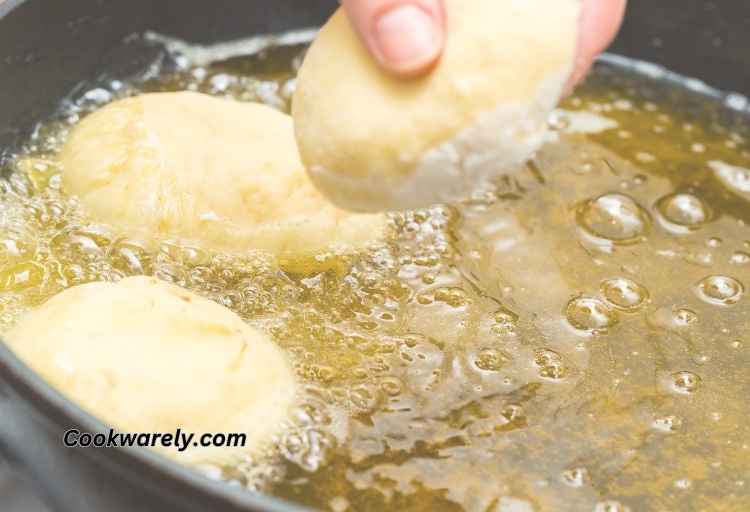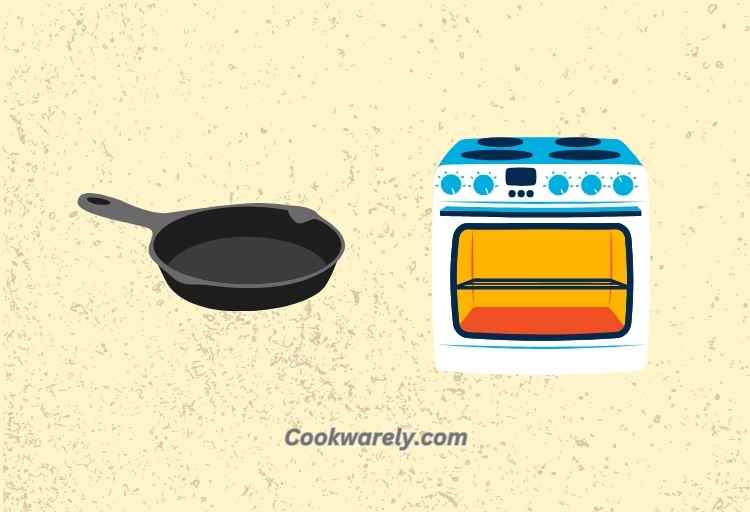4 Considerations on How To Store Chafing Dishes
How To Store Chafing Dishes? To store chafing dishes, first clean and dry them thoroughly. Then, store them in a dry, protected location such as a cabinet or pantry, or use a chafing dish cover to protect them.
You should avoid storing them in extreme temperatures or damp or humid areas to prevent rust and damage. Regular cleaning and maintenance can also help keep chafing dishes in good condition.
In this guide, I’ll discuss some effective and practical ways to store chafing dishes so they remain in good condition and are ready to use again when the next party rolls around.

Factors to Consider When Storing Chafing Dishes
Following are the factors that you should consider when storing the chafing dishes:
1. Essential Needs Chafing Dish Storage
When storing essential needs chafing dishes, consider their size and material. Stackable chafing dishes should be securely stacked to optimize space.
It is important to clean and dry them thoroughly before storage to prevent any buildup of moisture or food residue, which can lead to unpleasant odors or damage.
Utilize protective covers or storage bags to safeguard the chafing dishes from dust, scratches, or other potential damage.
2. Restaurant Chafing Dish Storage
For restaurants, efficient chafing dish storage is crucial due to the larger quantity of dishes involved.
Consider investing in storage racks or shelves specifically designed for chafing dishes. These racks help organize and stack the dishes safely, maximizing space and ease of access.
Labeling or color-coding can aid in identifying different types or sizes of chafing dishes, streamlining the retrieval process during busy periods.
Regular cleaning and inspection of stored dishes will help maintain their quality and prolong their lifespan.
3. Wire Chafing Dish Rack Storage
Wire chafing dish racks are used to hold chafing dishes above a heat source. When storing wire chafing dish racks, make sure they are thoroughly cleaned and dried to prevent rust or corrosion.
They should be stored in a dry area to avoid moisture damage. Consider disassembling or folding the racks to save space and protect them from accidental damage.
Storing them alongside other related accessories, such as sterno cans or fuel, can enhance organization and accessibility.
4. Chafer Storage Containers
Chafer storage containers are designed to store and transport chafing dishes. These containers provide protection against impact, dust, and moisture.
When storing chafers in these containers, ensure they are clean and completely dry to prevent any potential mold or mildew growth.
Use dividers or padding within the container to prevent scratching or movement during transport.
Labeling or inventory lists can aid in identifying the contents quickly, ensuring the correct chafer is retrieved when needed.
Summary: The key factors for storing chafing dishes include proper cleaning and drying, utilizing stackable options where applicable, utilizing storage racks or shelves, protecting against dust and damage, and employing organizational tools such as labeling or color-coding. By following these practices, chafing dishes can be stored efficiently, maintained in good condition, and readily accessible when required.
How To Store Chafing Dishes?
If you’re someone who frequently hosts parties or caters for events, you know how essential chafing dishes are for keeping food warm and appetizing.
But when the party is over, you’re left wondering how to store these bulky and awkward dishes.
So, how to store dishes? chafing dish storage is crucial to ensure they remain in good condition and are ready to use again when needed.
1. Cleaning and Drying
Before putting your chafing dishes away, it’s important to ensure they are thoroughly cleaned and dried. If any food or moisture is left behind, it can lead to rust or bacterial growth. Here are some tips for properly cleaning and drying your chafing dishes:
- Wash the chafing dishes with warm, soapy water and a sponge or scrub brush. Be sure to get into all the nooks and crannies, including the legs and handles.
- Rinse the chafing dishes thoroughly with clean water to remove any soap residue.
- Dry the chafing dishes completely with a clean towel or cloth.
- If the chafing dishes have removable food pans, be sure to clean and dry those as well.
- After drying them you can keep them in chafing dish storage containers.
2. Storing the Chafing Dishes
Once your chafing dishes are clean and dry, it’s time to find a suitable place to store them. Here are some options to consider:
- In a cabinet or pantry: If you have space in your kitchen, a cabinet or pantry can conveniently store your chafing dishes. Just make room for them and ensure they are protected from potential damage.
- In a storage closet: If you don’t have room in your kitchen, a storage closet or other out-of-the-way spot can work well. Just ensure the closet is dry and not prone to fluctuations in temperature, which can cause the chafing dishes to rust or become damaged.
- In a storage shed or garage: If you don’t have indoor storage options, a storage shed or garage can work as long as they are protected from the elements. Just be sure to wrap the chafing dishes in a protective cover or plastic wrap to prevent them from getting dirty or damaged.
3. Protecting the Chafing Dishes
To keep your chafing dishes in good condition, it’s important to protect them from potential damage. Here are some tips for doing so:
- Cover the chafing dishes with a protective cover or plastic wrap: This will keep dust, dirt, and other debris from accumulating on the chafing dishes and prevent them from getting scratched or dented.
- Use bubble wrap or other protective materials: If you’re storing the chafing dishes in a closet or other tight space, consider wrapping them in bubble wrap or other protective materials to prevent them from getting bumped or scratched.
- Keep the chafing dishes away from extreme temperatures: Avoid storing them in a very hot or cold place, as this can cause rust or damage.
4. Maintaining the Chafing Dishes
Even if you take good care of your chafing dishes, they may still need some maintenance from time to time. Here are some tips for keeping your chafing dishes in good condition:
- Keep an eye out for rust: If you notice any rust forming on your chafing dishes, you can try to remove it with a scrub brush and some rust remover. If the rust is severe, it may be best to replace the chafing dish.
- Protect the chafing dishes from scratch: If you notice any scratches or dents on your chafing dishes, you can try to buff them out with a metal polish or a soft cloth. This will help restore the shine and protect the chafing dishes from further damage.
- Store the chafing dishes correctly: As mentioned in the previous sections, storing your chafing dishes in a dry and protected location prevents rust and other damage.
- Keep the chafing dishes clean: Regularly cleaning and drying your chafing dishes will help prevent the buildup of food and moisture, which can lead to rust and bacterial growth.
By following these maintenance tips, you can help keep your chafing dishes in good condition for many parties to come.
5. Using Chafing Dish Covers
An alternative to storing chafing dishes is to use chafing dish covers, designed specifically to protect and cover the dishes when not in use. These covers are typically durable and waterproof and come in various sizes to fit different chafing dish sizes.
To use a chafing dish cover, place it over the chafing dish and secure it in place using the built-in elastic bands or Velcro straps. This will keep the chafing dish clean and protected from dirt, dust, and other debris.
One of the benefits of using chafing dish covers is that they take up less space than storing the chafing dishes themselves. This can be especially useful if you don’t have a lot of storage space or if you only use your chafing dishes occasionally.
How to Clean Chafing Dishes?
To clean chafing dishes, follow these steps:
- Remove any leftover food and discard it.
- Fill the dish with warm soapy water and let it soak for 15-30 minutes.
- Use a sponge or cloth to scrub the surface, paying special attention to any stubborn food residue.
- Rinse the dish with warm water to remove any soap residue.
- Dry the dish thoroughly with a clean cloth or let it air dry.
How do you organize chafing dishes?
Chafing dishes come in a variety of shapes and sizes. You can buy them in either an oval, round, or rectangular shape. Oval chafing dishes are typically used for main courses, while rectangular ones are ideal for serving sides or desserts.
These dishes can be heated by electricity or canned heat. The latter type is ideal for event planners who do not have access to electricity, and it is more portable than an electric version.
Chafing dish racks come in different styles and materials. You can find them in stackable units or buy decorative ones with lattice patterns and scrolled ironwork.
There are also chafer racks that include matching dishes and lids. You can also purchase plastic or wooden chafing dish storage box.
If you’re throwing a buffet event, chafing dishes is essential to your preparations. They make serving large groups of people easy.
They also allow you to serve various types of food to your guests and give you more time to socialize with them.
How Do You Display Chafing Dishes?
To display chafing dishes, you can use the following methods:
- Place the dishes on a buffet table or serving station.
- Arrange the dishes on a decorative platter or tray.
- Use a chafing dish stand to elevate the dishes and make them more visible.
- Create a themed or coordinating display by arranging the dishes with other serving pieces, such as platters, bowls, and utensils.
- Use table linens, such as tablecloths, table runners, or doilies, to enhance the presentation.
How to keep chafing dishes rust free?
Chafing dishes are necessary for serving hot food at parties or other events. These dishes come in various shapes and sizes and typically have a water pan heated by a chafer fuel candle or an electric source.
Some induction chafers do away with the water pan and fuel altogether. Follow a few simple steps to keep chafers looking good for as long as possible.
First, make sure that the chafer is clean. This will prevent rust from occurring. Use a dish cleaner or mild soap to remove any stains. A microfiber cloth will work well to wipe off food debris. Afterward, keep the chafer dry.
Another way to keep your chafing dishes rust-free is to use high-quality commercial-grade stainless steel.
This material is more durable, rust-proof, and heat-resistant. Stainless steel chafers are often sold with dual fuel holders. They can be used for both warming and buffet serving.
How to Hide Chafing Dishes?
To hide chafing dishes, you can use the following methods:
- Cover the dishes with lids or covers specifically designed for this purpose.
- Use tablecloths or table runners to cover the dishes and create a more attractive appearance.
- Place the dishes in serving carts or rolling cabinets with doors that can be closed when not in use.
- Arrange the dishes on shelves or in cabinets where they are not visible from the dining area.
- Create a decorative screen or partition to hide the dishes from view.
How to Store Chafing Fuel?
When it comes to storing chafing fuel, it is important to prioritize safety and follow specific guidelines. First and foremost, ensure that the chafing fuel is stored in a cool, dry, and well-ventilated area.
Direct sunlight, heat sources, and open flames should be avoided to prevent any potential accidents or fuel leakage. It is crucial to keep the containers tightly sealed or capped to maintain the integrity of the fuel and prevent spills.
To further minimize risks, store the chafing fuel away from flammable materials, such as paper, fabric, or other chemicals. It is also advisable to keep the fuel separate from food items or food preparation areas to avoid accidental contamination.
If you have partially used chafing fuel cans, placing them in a separate container or tray can help catch any potential drips or leaks. Labeling and dating the containers will ensure proper rotation and usage.
Lastly, it is essential to follow the manufacturer’s instructions for any specific storage recommendations, as different types of chafing fuel may have varying requirements.
By adhering to these precautions, you can safely store chafing fuel and minimize the risk of accidents or hazards.
Types of Chafing Dishes
Chafing dishes are serving dishes that are designed to keep food warm during a meal. They are commonly used at buffet-style events, such as weddings, banquets, and other large gatherings. There are several different types of chafing dishes, each with its own unique design and features.
Electric Chafing Dishes:
These are chafing dishes that are powered by electricity. They usually have a heating element at the base of the dish that keeps the food warm. They are easy to use and convenient because they don’t require any external heating sources.
Fuel-based Chafing Dishes:
These chafing dishes use fuel, such as sterno or gel fuel, to keep the food warm. The fuel is placed in a holder beneath the dish and ignited to heat the dish. These types of chafing dishes are typically less expensive than electric ones.
Induction chafing dishes:
These are chafing dishes that use induction technology to keep the food warm. They work by creating an electromagnetic field that heats the dish from the inside out. Induction chafing dishes are energy-efficient and provide precise temperature control.
Roll-top Chafing Dishes:
These chafing dishes have a hinged lid that rolls back to provide easy access to the food. They are convenient for serving large quantities of food because they don’t require the lid to be removed completely.
Round Chafing Dishes:
These chafing dishes are round in shape and come in various sizes. They are ideal for serving soups, stews, and other dishes that require a deep dish.
Rectangular Chafing Dishes:
These chafing dishes are rectangular in shape and also come in various sizes. They are ideal for serving foods that are longer in shape, such as lasagna or sliced meat.
Conclusion
In conclusion, properly storing chafing dishes is important to ensure they remain in good condition and are ready to use when needed. Be sure to clean and dry the chafing dishes thoroughly before storing them, and protect them with a cover or other protective materials. By following these tips, you can keep your chafing dishes in top condition for many parties.
FAQs:
How to Use Chafing Dish?
Fill the water pan with hot water, place food in the chafer dish, and ignite the fuel source to keep the food warm.
Are Plastic Chafing Dish Covers Good?
Plastic chafing dish covers can be useful for outdoor events or transporting food, but they may not be as durable as metal covers.
How to Clean Stainless Steel Chafing Dishes?
Use warm soapy water and a soft sponge to clean the chafing dish, rinse with water, and dry with a clean cloth. For stubborn stains, use a non-abrasive cleaner.





